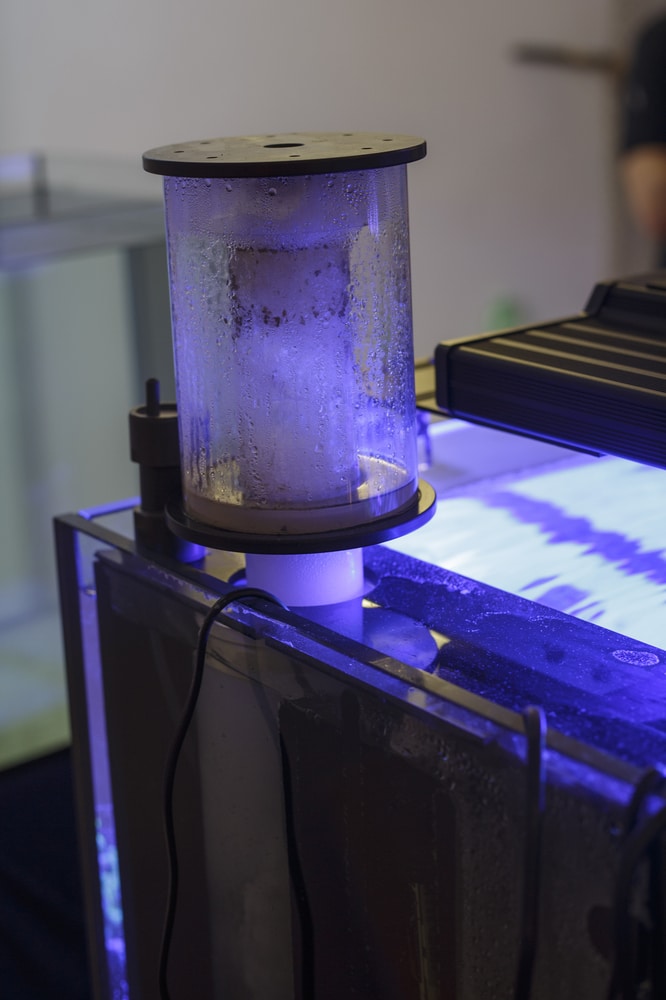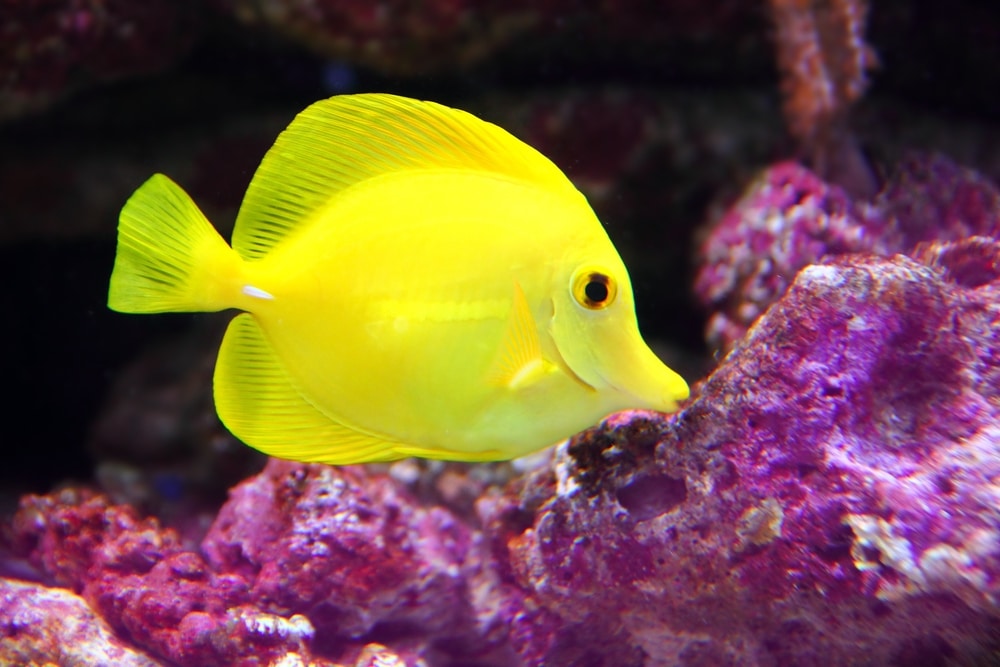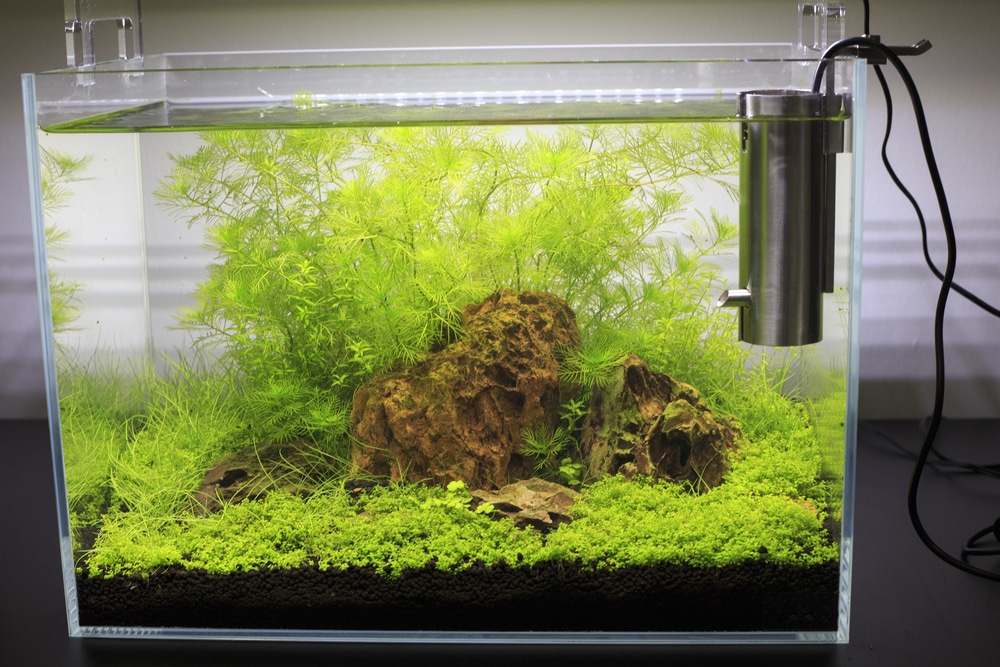Saltwater aquariums get an unfair rap versus freshwater ones. Saltwater is often seen as expensive, difficult, and time consuming while freshwater is basic, cheap but full of drab, boring fish.
While there are some partial truths hidden in these assumptions it’s also safe to say that it’s not so easy to generalize both systems.
Instead of making broad assumptions I think it’s better if we delve into the real differences between saltwater versus freshwater aquariums!
Saltwater vs Freshwater Aquarium Differences
Here are a few key differences you should note when deciding between a freshwater and saltwater aquarium:
Equipment and Chemistry
Freshwater aquariums can be just as technically challenging as saltwater. Fish like wild-caught Discus and Freshwater Stingrays can give many marine species a run for their money on sensitivity to water quality.
However if you’re keeping a saltwater fish-only tank with hardy specimens like Damselfish the only real difference is that you’re adding salt to your water. Other than marine salt and a hydrometer, everything else is the same. You still need a heater, you still need to monitor the pH, check hardness, ammonia and its breakdown byproducts, etc.
When mixing a saltwater solution you’re aiming for a specific gravity of about 1.026 at 68F, or 35 parts per thousand (35 grams per liter). Mixing instructions are always right on the bag. Dechlorination is done using chemical agents just like freshwater aquariums.
Things only get complicated when you add in stony corals and other invertebrates that pull minerals from the water. Hardness and minerals like calcium, magnesium, and strontium suddenly matter as growth factors for them. Monitoring phosphorus and nitrate are also even more important to keep them as low as possible.
Still, freshwater aquariums have similar concerns if you decide to grow live plants. Iron, phosphorus, nitrogen, and carbon sources are similarly tracked, added, and subtracted in the biological calculus of maintaining a healthy ecosystem.
Saltwater aquariums are almost always higher in pH versus freshwater, which are often neutral, soft, and even include highly acidic blackwater environments full of plant tannins. Freshwater water chemistry can easily get complicated when replicating biomes found in nature.
Protein Skimmers
When measuring water quality in freshwater versus saltwater setups organic matter buildup is a problem for both systems. Fish require food and they create waste in the process. This waste gets broken down by bacteria and other microorganisms into ammonia, nitrite, and eventually nitrates.

Nitrate is typically seen as the least toxic form of the ammonia decomposition chain. And while that’s true for both fish and plants (which actually use nitrate) corals are extremely sensitive to nitrate.
Therefore, it’s best to simply remove organic matter before it even has a chance to accumulate and decompose!
Many organic molecules are positively charged on one end and negative on the other. This imbalanced charge gives them an affinity for water molecules at one end and air on the other. And over time these molecules work their way to the surface air-water boundary where their electrical charges best equalize.
Protein skimmers create “extra surface” for molecules to collect at by generating bubbles and skimming off this layer of organic buildup. This prevents significant amounts of nitrates from ever forming, helping to keep corals pristine.
While nitrates are still a concern in freshwater ecosystems and 0ppm is ideal, levels of 5 to 10ppm are considered acceptable, making a protein skimmer overkill. With coral reef tanks, 0.25 to 5ppm are maximum values.
Lighting for Photosynthetic Organisms
When it comes to saltwater versus freshwater reef and planted aquariums have something else in common: photosynthetic creatures that eat light!
Corals and anemones are animals but have symbiotic algae living in their flesh that create sugar to supplement the protein rich animals and plankton they catch and consume.
And plants are famous for using carbon dioxide, water, and sunlight to create sugars for sustenance. Both setups use high intensity lighting to keep organisms other than fish happy and both plants and corals will wither and die without good lighting.
How much light depends both on the species and aquarium size you have in question but in general coral reef aquariums require significantly more light than most planted aquariums (necessitating a larger electricity bill at the end of the month).
Pricing for Fish and Invertebrates
While saltwater fish aren’t necessarily always more expensive (see the “common saltwater vs freshwater aquariums myths” section below) they are more expensive on average. Why is that?
Rarity and Water Depth
Many popular saltwater come from remote regions of the planet and nowhere else. Potter’s Pygmy Angelfish, for example, is not uncommon in the trade. However it is found exclusively in the Hawaiian Islands and Johnston Atoll region.
This small geographic region combined with the increasingly strict regulations placed on marine fish collection in Hawaii drives up the price to $100-$150.
Even more remote fish like the Peppermint Angelfish, native to deep waters (50-120m) surrounding the Cook Islands and Rarotonga, can fetch thousands of dollars. A single specimen once sold for $30,000! The depth is as challenging as the remoteness of these islands – a rapid ascent can kill deep water fish, making collection even more challenging for divers.
There are plenty of freshwater fish endemic to small lakes, streams, and rivers as well. However their ease of breeding and land access tends to make this factor less of a concern over time.
Rift Lake Cichlids are all endemic to a few African Great Lakes but are also almost exclusively captive bred save rare species that are too niche for most hobbyist’s tastes.
Even true wild caught endemic species like Rainbowfish are nowhere near as expensive because collection is easier and transport costs are far lower compared to versus saltwater species.
Specialist Feeders (sponges, coral, etc)
Specialist feeders are a challenge in both systems but this comes up far more frequently with saltwater fish. Mandarin Dragonets are a classic example. While they look strong and healthy when first seen at the aquarium store prowling live rocks and reef aquariums the majority die out when taken home. Why?
It turns out Mandarin Dragonets are specialist amphipod and copepod feeders. Once they consume all of these tiny crustaceans they don’t readily accept typical marine fish food – frozen and prepared fare.
They are also slow moving bottom dwellers that simply can’t compete with the surface-churning intensity of other fish.
Saltwater Angelfish are another example. Many, especially the largest Holocanthus genus, are specialist sponge feeders. Up to 90% of their stomach contents are sponges with a bit of algae, bryozoan, and invertebrates for variety.
This means we need to offer special marine angelfish formulas that include sponges but are expensive compared to prepared foods.
Inhabitant Choices For Saltwater vs Freshwater
Are inhabitants you main concern? Here are a few things to keep in mind:
Saltwater Aquariums: More Brightly Colored Fish

If you love intense colors then saltwater fish really can’t be beat. Some freshwater fish can compare – Killifish, Fancy Guppies, and rift lake Cichlids come close in terms of the sheer gaudy display of reef dwellers.
But even they are questionable challengers to the intense hues of a Regal Angelfish, gauzy elegance of the Lionfish, and surreal chaos of the Mandarin Dragonet.
The colors of saltwater fish are far more functional than mere beauty, however. For starters, visible light penetrates deep water in a complex way, which changes how saltwater fish actually look in nature compared to a shallow aquarium.
Also, given the riot of colors already found thanks to corals and other reef building creatures the patterns of many marine fish actually help them blend in by breaking up their outline and making it harder for predators to track them.
Colors are also signs of communication – many saltwater creatures are poisonous or venomous and use bold colors and fins to stand out as warning signs, a common phenomenon in nature known as Aposematism.
Bold colors can also communicate their willingness to act as cleaners, such as Blood Red Fire Shrimp, young Angelfish, and Cleaner Wrasses.
When we compare versus freshwater fish, the drab greens and browns of lakes, ponds, and streams encourage camouflage patterns that use similar tones. When breeding season comes around many males will take the risk of standing out. However most female freshwater aquarium fish are slightly to significantly duller in color relative to males.
Wider Invertebrate Selection for Saltwater
When it comes to saltwater versus freshwater invertebrates are a clear win for marine enthusiasts! Freshwater aquariums may be home to not only fish but snails, shrimp, snails, clams, mussels, crayfish, and even extremely rare freshwater sponges.
However, saltwater aquariums really do have a monopoly on invertebrates. Freshwater enthusiasts do get a large number of shrimp, ranging from the muted ghost shrimp to the intensely colored Red Cherry Shrimp. The vast majority are rather cryptic in coloration unless captive bred to be otherwise, however.
They can’t compete with the boldly colored, dizzying array of saltwater choices, from lanky Coral Banded Shrimp and Blood Red Fire Shrimp to Anemone and Pistol Shrimp. Even the usually unwanted Peacock Mantis Shrimp is fascinatingly beautiful.
Giant Clams and Flame Scallops with their brilliantly hued mantles are easily found, as are Hermit, Emerald, and Arrow Crabs. Live rock includes hitchhikers like Christmas Tree Worms, Nerite Snails, Hydrozoans, dwarf Anemones, and soft and stony corals.
Anemones and Corals also are show specimens of themselves. The only cnidarians you’re going to find in saltwater are Hydra, which are anywhere from tiny to microscopic.
Freshwater Aquariums: Less Impact on Threatened Wild Stocks
This is an important, sometimes overlooked aspect of the aquarium hobby. In the United States we currently import around 11 million tropical fish a year, many of which are collected through methods like cyanide collection, which can cripple and kill fish besides the target specimens.
While wild caught fish can be found in both aspects of the trade freshwater fish are far more likely to be captive bred because their reproductive requirements are usually less involved compared to marine fish.
Many saltwater fish are pelagic spawners; they release tons of eggs and sperm directly into the water column where they develop in free floating conditions amidst the zoo and phytoplankton that forms their source of food.
On the other hand, many freshwater fish stick their eggs onto plants and rocks or even build nests for them because current would otherwise carry their floating eggs directly into the sea.
Advanced are constantly being made in breeding saltwater fish – clownfish are increasingly captive bred and even some of the more difficult pelagic spawners like Yellow and Blue Tang are starting to give up their secrets.
It is also true that some freshwater species haven’t been captive bred enough to meet demand and are threatened in the wild, including Denison’s Barb and Freshwater Stingrays.
However marine stocks are far more threatened by the aquarium trade because it’s such a profitable industry and few people want to invest in breeding them – a business that’s already known to be difficult with low chances of returns.
Wider Plant Selection for Freshwater

When it comes to the first photosynthetic organisms that spring to mind, your choices for the saltwater aquariums include…Algae. Coralline Algae is quite attractive when it isn’t coating everything in a purple-pink crust but doesn’t have the impact of an elegant Amazon Sword or Madagascar Lace Plant.
Corals, anemones, sponges, and other sessile invertebrates are the obvious analogue to freshwater plants. However most corals are far more temperamental and their lighting requirements are more complex.
Many plants, such as Java Moss and Hornwort, don’t even require specialized lighting. Low light plants will thrive under standard aquarium bulbs and many also don’t need added fertilizers.
Aquarium plants also grow faster than coral and are less of a worry if a fish decides to start nibbling on them because they are much more resilient to pruning. Corals and anemones, being animals, are more sensitive to predation.
Common Myths
Several misunderstandings about the nature of saltwater versus freshwater aquariums persist. Some of these include:
“Freshwater Fish Are Inexpensive!”
The most expensive aquarium fish ever sold was an albino Asian Arowana, valued at $300,000. It’s true that on average, going to the pet store you’re going to be paying more to stock a saltwater tank versus a freshwater one.
However if your tastes go beyond Guppies and Barbs, freshwater fish can easily break the bank. Fancy Discus, specialty Koi, Rift Lake Cichlids, and wild-caught fish like Freshwater Stingrays can easily top hundreds to thousands of dollars.
“Saltwater Aquariums Have to be Big!”
This is partially but not entirely true. Saltwater holds about 80% of the oxygen of freshwater so the carrying capacity is lower. However nano reefs and nano fish-only saltwater tanks are definitely a thing. You simply have 20% less fish compared to freshwater.
There seems to be more commonly available larger fish in the marine trade as well relative to freshwater fish. Many colorful, popular fish, like Neon Tetras, are an inch long. But many popular “small” saltwater fish are 2-3 inches in length, including Common Clownfish, Chalk Bass, and the smallest Dwarf Angelfish.
There are very few fish two inches or under, which necessitates a larger aquarium. However there are some, including Neon Gobies and Percula Clownfish. It just takes more work to find them versus freshwater aquariums.
“Freshwater Aquariums Are Easier to Maintain!”
Not true. Freshwater aquariums are simply maintained differently versus saltwater ones. The most advanced coral reef setups are definitely more expensive.
However a well aquascaped specialist freshwater setup can be just as intensive in terms of plant maintenance, chemistry, lighting requirements, and animal behavior. And a basic fish-only setup for saltwater can be just as easy as freshwater, with salt added each water change being the only real difference.
“Saltwater Fish are More Sensitive!”
This myth is partially true because Saltwater fish are more often wild caught. While this is slowly changing and many popular species such as Clownfish and even some Angelfish are captive bred, shipping wild caught fish across the world is a stressful process.
The problems worsen when you add brute force collection methods like cyanide fishing, which helps collectors stun fish but often killing them over the course of months. Enough time for your new Tang to make it to your aquarium only to die mysteriously and undetectably.
Wild caught fish, both fresh and saltwater, not only come from stable, often pristine environments, but are used to their native food sources.
Trying to encourage them to eat dead flakes and pellets may not always be possible and the constant shifts in temperature and water quality that can occur in transport weakens them further.
Conclusion
Overall, I think it is safe to say that freshwater has plenty to offer versus saltwater and that neither system is better or worse than the other.
Both aquarium designs offer the possibility for stunning ecosystems full of lively creatures and are well worth getting to know!
If you find the vivid colors of marine fish and reef building corals irresistible then get to know protein skimmers, PAR levels, and strontium.
If, on the other hand, mixing your own substrates, plants bubbling with oxygen, and a less invertebrate intensive setup are what you prefer, freshwater fish have a lifetime of choices to offer!


One other thing to note (something that doesn’t come up too often but that I realized very quickly when I started researching saltwater fish) is that most freshwater fish need to be kept in groups of the same species while almost all saltwater fish are territorial towards each other.
This can also have an impact on price; for example tetras may be cheaper than clownfish *individually*, but since you’ll need to be at least 6-10 of them on average the cost can add up, while with clownfish you’ll only be getting one or, at most, a pair.
Naturally this also impacts stocking, as even a fairly small saltwater tank can have a greater diversity of species than a freshwater tank of the same size.